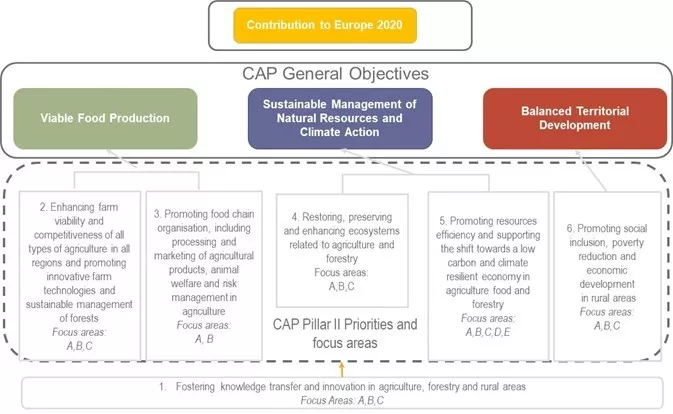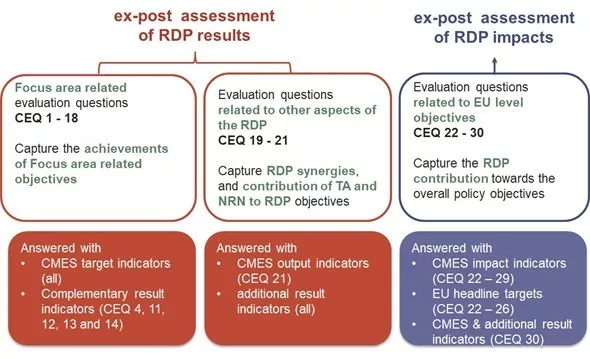Learning Portal - Ex post evaluation of the RDPs 2014-2022
Learn more about why and how to conduct the ex post evaluation of the Rural Development Programme in your country or region. Study the reporting template and get inspired from practical evaluation examples from the Member States!
Page contents

Basics
The ex post evaluation is a summative evaluation conducted after the completion of policy interventions to demonstrate the achievements of policy objectives, impacts and results to stakeholders and the general public, and to increase transparency and learn how to do policy better in the future. It is conducted at a point where it is possible to assess impacts and the added value of the programme funding, both at EU and programme level.
The ex post evaluation is a policy learning tool, which enables the use of evaluation results to improve the design, quality and implementation of the policy in the future. Utilising evaluation in policy design, by drawing relevant conclusions and lessons, is an important aspect of evidence-based policymaking.
Even though the ex post evaluation is conducted at the end of a programming period, when the new policy is already designed and partly implemented, it has an important role in bridging the old and new programming periods. Relevant information and recommendations can be used to improve the implementation of the new programme, especially for measures which continue across programming periods.
Legal basis
Article 78 of Regulation (EU) 1305/2013 obliges Member States to carry out an ex post evaluation for each of their RDPs.
Article 79 of the same regulation requires the Commission to undertake a synthesis at Union level of the ex post evaluation reports.
The transitional Regulation (EU) 2020/2220 requires Member States to submit an ex post evaluation report for each RDP by the end of 2026.
The syntheses of the evaluation reports shall be completed by 31 December of the year, at the latest, following the submission of the relevant evaluations.
The legal basis on the scope of evaluation, including the ex post, is covered in the following:
- Article 54 of the Regulation (EU) 1303/2013
- Article 68 of the Regulation (EU) 1305/2013
- Article 14 of the Commission Implementing Regulation (EU) 808/2014
- Implementing Regulation (EU) 834/2014 on common indicators
Common elements for the ex post evaluation of RDPs
The following figure shows the intervention logic for Pillar II including the General Objectives, priorities and focus areas.

-
The figure illustrates the intervention logic of the Common Agricultural Policy (CAP) in the period 2014-2022 and its contribution to the Europe 2020 strategy. It outlines the CAP's three general objectives (Viable food production, sustainable management of natural resources and climate action, balanced territorial development). To these General Objectives the six Rural Development priorities (CAP Pillar II) contribute priorities, and focus areas to achieve these goals.
The second priority comprises of enhancing farm viability and competitiveness of all types of agriculture in all regions and promoting innovative farm technologies and sustainable management of forests (focus areas: A, B, C). The third priority consists of promoting food chain organization, including processing and marketing of agricultural products, animal welfare, and risk management in agriculture (focus areas: A, B). Priorities two and three fall under the general objective of viable food production.
The fourth priority deals with restoring, preserving, and enhancing ecosystems related to agriculture and forestry (focus areas: A, B, C). The fifth priority comprises promoting resource efficiency and supporting the shift towards a low-carbon and climate-resilient economy in agriculture, food, and forestry (focus areas: A, B, C, D, E). Priorities four and five fall under the general objective of sustainable management of natural resources and climate action.
The sixth priority is about promoting social inclusion, poverty reduction, and economic development in rural areas (focus areas: A, B, C), and it falls under the general objective of balanced territorial development.
Finally, the cross-cutting priority 1 deals with knowledge transfer and innovation in agriculture, forestry, and rural areas (focus areas: A, B, C) feeding into all other Rural Development priorities.
The CMES for Pillar II ensures that a common evaluation approach is applied across the RDPs and by all Member States, that progress and achievements of the rural development policy are demonstrated and assessed, taking into account the policy´s impact, effectiveness, efficiency and relevance (see Implementing Regulation (EU) 834/2014).
There are 30 ‘Common Evaluation Questions’ (CEQ) defined in Annex V of the Commission Implementing Regulation (EU) 808/2014 and – as in the enhanced AIR submitted in 2019 – all 30 CEQs should be answered by the Member States.
The Commission places particular emphasis on the quantification of the common indicators, including the Complementary Result Indicators (CRI).
Additional programme-specific evaluation questions/evaluation criteria may arise from the involvement of the EU Recovery and Resilience Facility (RRF) and possibly from new measures included in the programme, or also with regard to the impact of the COVID-19 pandemic.

-
This figure shows the structure of the 30 common evaluation questions (CEQs) to be assessed for the Rural Development Programmes (RDPs) during the period 2014-2022. It explains when they are to be assessed and based on which indicators of the Common Monitoring and Evaluation System (CMES).
The focus area-related CEQs 1 to 18 are answered based on all CMES target indicators and complementary result indicators, with the latter applicable to CEQs 4, 11, 12, 13, and 14.
The evaluation questions related to other RDP aspects (synergies, technical assistance, and national rural networks), namely CEQs 19, 20, and 21, are answered based on CMES output indicators (CEQ 21) and additional result indicators.
These two sets of CEQs focus on RDP results and are answered in 2017, 2019, and in the ex-post evaluation. In contrast, the last set of evaluation questions CEQs 22 to 30 EW related to EU-level objectives and are assessed only in 2019 and in the ex-post evaluation. They focus on RDP impacts and are answered based on CMES impact indicators (CEQs 22-29), EU headline targets (CEQs 22-26), and CMES and additional result indicators (CEQ 30).
Resources
| Documents | Relevance for the ex post evaluation 2014-2022 | CEQ covered |
|---|---|---|
| Guidelines - Assessing RDP achievements and impacts in 2019 |
Offers methodological support for assessing the common impact indicators of Pilar II (sectoral, environmental and socio-economic impacts). This guidance explains each intervention logic, the use of additional evaluation elements, explains the data requirements, the units of assessment and guides the reader through choosing the most appropriate evaluation approaches for netting out the RDP’s contributions to the values of the CAP impact indicators. Furthermore, Part II also suggests approaches to assess RDP contributions towards achieving the Europe 2020 strategy and innovation. Contains the fiches for answering the CEQs 22-30, technical annex including more detailed information on the approaches to assess the CAP impact indicators and a glossary of terms. |
All CEQs |
| Guidelines - Assessment of RDP results: how to prepare for reporting on evaluation in 2017 (separate Annex 11) | This document contains updated fiches for Complementary Result Indicators (CRI) 13, 14, 15, 18 and 19 and updated fiches for answering CEQs 11-14 for RDPs 2014-2020. | 1-21 |
| Updated fiches for answering Common Evaluation Questions 4 and 6 for RDPs 2014-2020 |
This document includes the updated fiches for answering CEQs 4 and 6 for the ex post evaluation of RDPs 2014-2022. These fiches have been updated by providing a non-exhaustive list of possible additional evaluation elements that Managing Authorities and evaluators may consider when preparing and conducting the assessment of competitiveness in agriculture. |
4 and 6 |
| Guidelines - Evaluation of LEADER/CLLD | Explains how to assess the primary and secondary contributions of LEADER/CLLD towards rural development focus areas. | 17 |
| Guidelines - Evaluation of National Rural Networks 2014-2020 | Clarifies the common elements related to National Rural Networks’ (NRN) evaluations and gives a wider set of recommendations on how to formulate and manage NRN evaluations, both as a stand-alone exercise and as a part of RDP evaluations. | 21 |
|
Interactive decision tools for impact indicators Interactive Decision Tool for I.01, I.02, I.03 Interactive Decision Tool for I.07 Interactive Decision Tool for I.08, I.09 Interactive Decision Tool for I.10, I.11 Interactive Decision Tool for I.12 Interactive Decision Tool for I.13 Interactive Decision Tool for I.14, I.15, I.16
|
These interactive decision tools can support in the selection of possible methods to be used based on the data available for the indicators selected. | 22-30 |
| Guidelines - Evaluation of innovation in RDPs 2014-2020 | Provides information on the assessment of the RDP contributions to the EU’s 2020 headline target investing 3% of the EU’s GDP in research and development and innovation and of the RDP contribution to innovation and on answering of CEQ 23 and 30. | 1, 2, 3 and 23 |
Reporting Template for the ex post evaluations of RDPs 2014 - 2022
This technical template has been developed as a basis for preparing structured reporting of the Member States’ evaluation findings in relation to the ex post evaluation of RDPs 2014-2022. It is used by DG AGRI as a basis to prepare the electronic SFC 2014 reporting format for the ex post evaluation.
All CEQs.
Reporting Template for the ex post evaluations of RDPs 2014 - 2022
(PDF – 359.62 KB)
European Commission fiches for indicators
| Title and link | Relevance for the ex post evaluation 2014-2022 | CEQ covered |
|---|---|---|
| Target and result indicator fiches for Pillar II (Priorities 1 to 6) | Shows the links to the respective priority and focus area for each indicator, the definition and unit of measurement, the methodology for its calculation, data needs and sources, the frequency of collection and the means of transmission to the Commission. | 1-5 |
| Complementary result indicators fiches for Pillar II | Contains similar guidance for each of the complementary result indicators. | 1-21 |
| Context indicators fiches |
45 CAP common context indicators (divided into three groups – socio-economic, sectorial, and environmental) reflect relevant aspects of the general contextual trends in the economy, environment and society. These will likely influence the implementation, achievements and performance of the CAP. Indicator factsheets describe definitions, methodology and data sources. |
22, 23, 24, 25, 30 |
| Impact indicators fiches for Pillar II | Contains similar guidance for each impact indicator. | 22-30 |
Learning from practice
Approaches to Assess Socio-economic and Sector Related RDP Impacts in 2019
Approaches to Assess Environmental RDP Impacts in 2019
How to demonstrate RDP achievements and impacts: lessons learned from the evaluations reported in the AIRs 2019
Assessment of Resource Efficiency and Climate
Assessing the Contribution of RDPs to a Competitive and Viable Agricultural Sector
- Good Practice Workshop – Assessing Environmental Effects of Rural Development Programmes: Practical solutions for the ex post evaluation 2007-2013
The aim of the workshop was to facilitate an exchange between Member States with regard to their practical challenges in assessing RDP’s environmental results and impacts in the context of the ex post evaluation of 2007-2013. Lesson learned can be applied for the ex post in the current period.
CEQ: 8-15, 26 and 28 - Good Practice Workshop – Methods for assessing impacts of Rural Development Programmes 2007-13: Practices and solutions for the ex post evaluation
This workshop looked at lessons from the ex post evaluations of the 2007-2013 programming period. Lessons can be carried over to the current period.
CEQ: 22-30